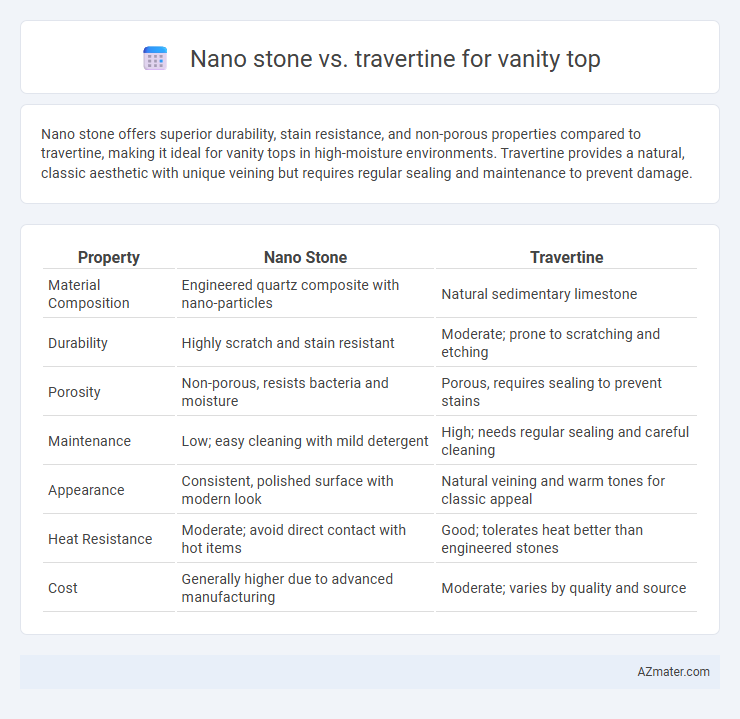Nano stone offers superior durability, stain resistance, and non-porous properties compared to travertine, making it ideal for vanity tops in high-moisture environments. Travertine provides a natural, classic aesthetic with unique veining but requires regular sealing and maintenance to prevent damage.
Table of Comparison
| Property | Nano Stone | Travertine |
|---|---|---|
| Material Composition | Engineered quartz composite with nano-particles | Natural sedimentary limestone |
| Durability | Highly scratch and stain resistant | Moderate; prone to scratching and etching |
| Porosity | Non-porous, resists bacteria and moisture | Porous, requires sealing to prevent stains |
| Maintenance | Low; easy cleaning with mild detergent | High; needs regular sealing and careful cleaning |
| Appearance | Consistent, polished surface with modern look | Natural veining and warm tones for classic appeal |
| Heat Resistance | Moderate; avoid direct contact with hot items | Good; tolerates heat better than engineered stones |
| Cost | Generally higher due to advanced manufacturing | Moderate; varies by quality and source |
Introduction to Nano Stone and Travertine Vanity Tops
Nano stone vanity tops are engineered surfaces composed of natural quartz and resin, offering exceptional durability, scratch resistance, and low porosity, making them a hygienic choice for bathroom environments. Travertine vanity tops, crafted from natural limestone with distinctive veining and warm earthy tones, provide a timeless and elegant aesthetic but require regular sealing to prevent staining and damage due to their porous nature. Selecting between nano stone and travertine depends on balancing the desire for low-maintenance, long-lasting surfaces with the appeal of natural stone's unique texture and appearance.
Composition and Material Properties
Nano stone vanity tops are engineered from a combination of natural quartz, resin, and nano-sized particles, providing superior hardness, non-porosity, and resistance to scratches and stains. Travertine, a natural sedimentary limestone primarily composed of calcium carbonate, features a porous texture that requires sealing to prevent moisture absorption and staining. The dense, non-porous composition of nano stone offers enhanced durability and low maintenance compared to the more delicate, porous structure of travertine in bathroom vanity applications.
Aesthetic Appeal and Design Versatility
Nano stone offers a sleek, modern aesthetic with a uniform surface that enhances minimalist and contemporary vanity top designs, while travertine brings natural warmth through its unique veining and porous texture, ideal for rustic or classic styles. The design versatility of nano stone includes a wide range of colors and finishes due to its engineered composition, enabling customization to fit various interior themes. Travertine's organic patterns and earthy tones provide a timeless elegance but require sealing to maintain durability and appearance in bathroom environments.
Durability and Strength Comparison
Nano stone exhibits superior durability and resistance to scratches, stains, and heat compared to travertine, making it an ideal choice for vanity tops subjected to daily wear and tear. Travertine, a natural limestone, is more porous and softer, which increases its susceptibility to etching and chipping over time without proper sealing and maintenance. The high density and engineered composition of nano stone provide enhanced strength and longevity, ensuring a more resilient surface in bathroom environments.
Stain and Scratch Resistance
Nano stone offers superior stain and scratch resistance compared to travertine, making it an ideal choice for vanity tops in high-use bathrooms. Its dense, non-porous surface prevents absorption of liquids and resists scratches from daily wear and tear, ensuring lasting durability and low maintenance. Travertine, a porous natural stone, is more prone to staining and scratching unless regularly sealed and carefully maintained.
Maintenance and Cleaning Requirements
Nano stone offers superior resistance to stains and scratches compared to travertine, making it easier to maintain and clean without specialized sealants. Travertine, being a porous natural stone, requires regular sealing to prevent moisture absorption and staining, demanding more consistent upkeep. Routine cleaning of nano stone involves simple wiping with mild soap and water, whereas travertine needs pH-neutral cleaners to avoid damage and discoloration.
Cost Analysis and Budget Considerations
Nano stone vanity tops typically cost between $60 to $100 per square foot, offering a durable and low-maintenance option for budget-conscious buyers. Travertine ranges from $50 to $75 per square foot but requires additional sealing and maintenance expenses, potentially increasing long-term costs. Budget considerations should weigh initial purchase price against upkeep, with nano stone often providing better value through enhanced durability and resistance to stains.
Environmental Impact and Sustainability
Nano stone offers superior sustainability compared to travertine due to its composition of engineered materials that require less natural resource extraction. Travertine, a natural stone, involves quarrying processes that contribute to habitat disruption and higher carbon emissions. Nano stone's durability and low porosity reduce the need for frequent replacements, further minimizing environmental impact over the product's lifecycle.
Installation Process and Practicality
Nano stone offers a streamlined installation process due to its lightweight and uniform composition, making it easier to handle and fit in tight bathroom spaces compared to the heavier, more brittle travertine. Travertine requires careful sealing and skilled installation to prevent cracking and staining, which can extend project timelines and increase labor costs. Nano stone provides higher practicality for vanity tops with its resistance to moisture, staining, and scratching, ensuring long-lasting durability and low maintenance.
Which is Best for Your Vanity Top: Nano Stone or Travertine?
Nano stone offers superior durability and stain resistance compared to travertine, making it ideal for high-traffic bathroom vanity tops prone to water exposure and daily use. Travertine, a natural limestone with unique veining, provides an elegant, classic aesthetic but requires regular sealing and careful maintenance to prevent staining and etching. For a low-maintenance, long-lasting surface, nano stone is the best choice, while travertine suits those prioritizing natural beauty and are willing to invest in upkeep.

Infographic: Nano stone vs Travertine for Vanity Top
 azmater.com
azmater.com